This easy Homemade Pie Crust recipe is tender, flaky, delicious, and it’s easy to make with just 4 simple ingredients. Use it for baked or no-bake pies, mini pies, hand pies, a slab pie, and more. I’ve included helpful tips and step by step instruction photos to help guide you into pie crust perfection!
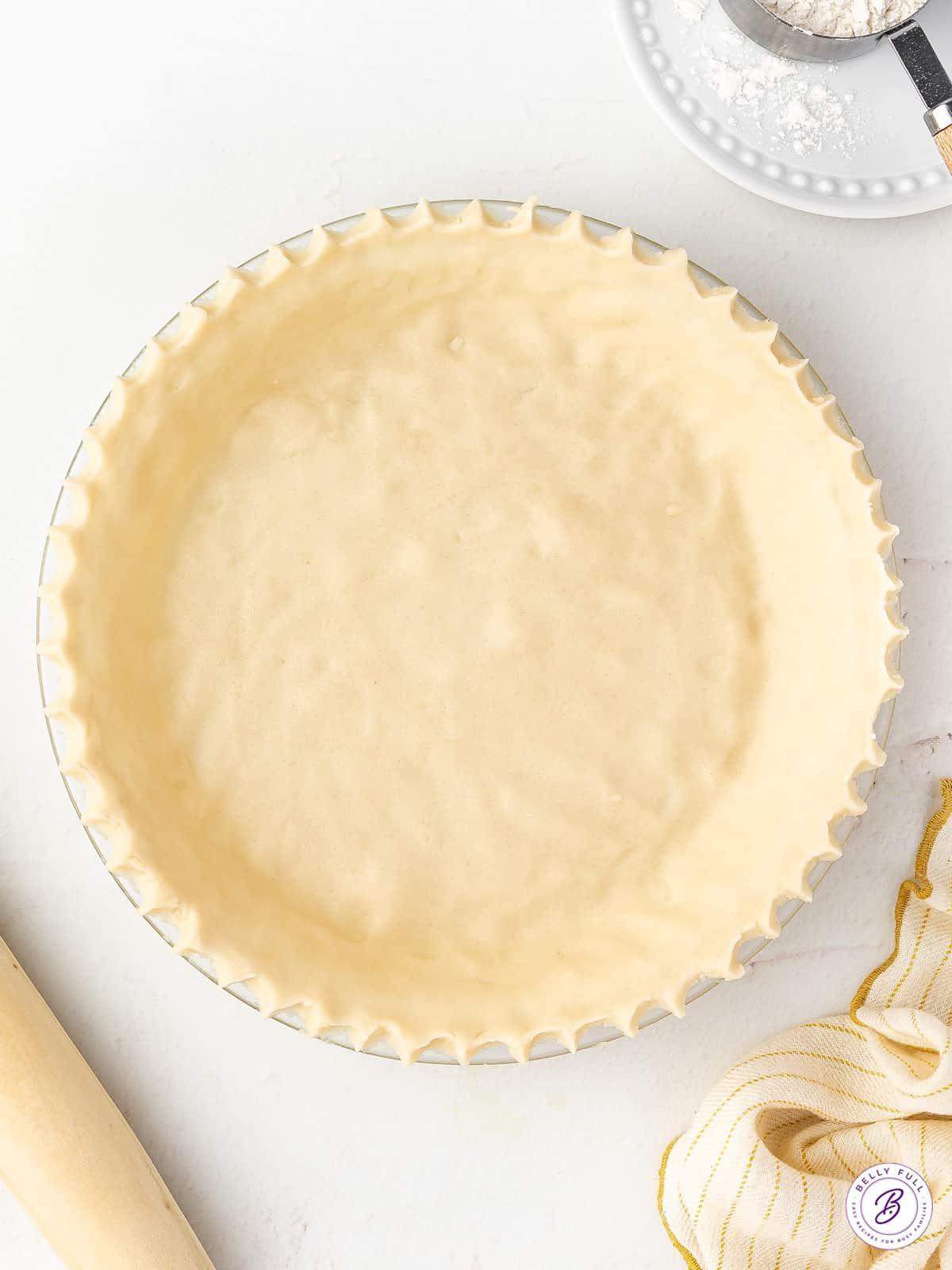
This pie crust recipe is the one my mom has been using for over 50 years, which I stole from her after I got married 20 years ago. It is really easy and foolproof!
There are different techniques to making a pie crust; some bakers use butter only, some shortening only, and others use a combo of butter and shortening. Some use a food processor to combine the ingredients, others use a pastry blender. Some transfer the dough to the pie plate with a rolling pin, while others fold into quarters. Some use a fork to crimp the edges, some use their fingers. It’s all personal preference and an argument that will go down in history as to which is the best way.
No matter how you do it, it takes practice! Don’t be scared, though. Look at it like a challenge – a fun challenge. A challenge that will result in something delicious, where you can shout out on social media, “Hey look!! I made a pie crust!” *fist bump*
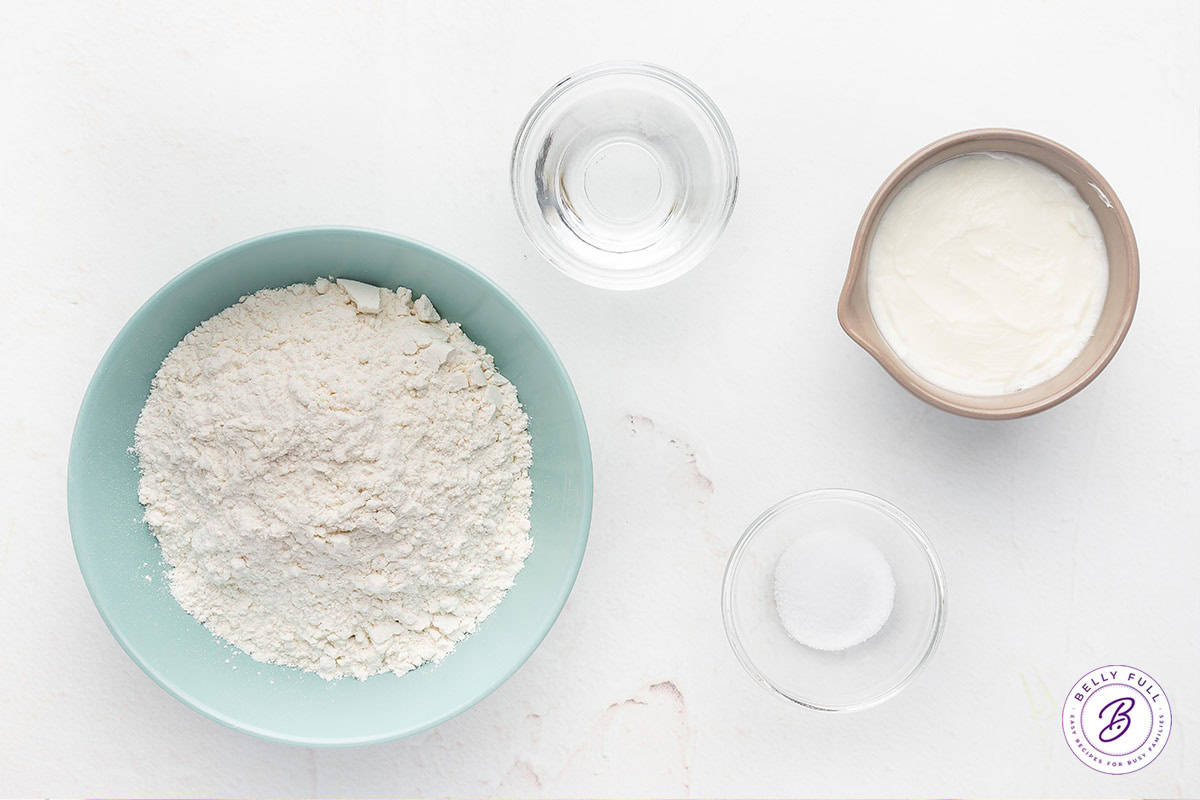
What’s in this Pie Crust recipe?
For this pie crust recipe, all you need is 3 simple pantry items and ice cold water. While a short list, all the items are critical. You can find the exact measurements in the recipe card below.
- Flour – Simple all-purpose plain flour.
- Shortening – This provides the dough with structure. Yep, I prefer shortening over butter. Shortening has a high melting point which aids in creating extra flakiness and also holds its shape better. Having said that, if you’re opposed to shortening, this recipe does work with butter. (Note: if you ever have a chance to taste a pie crust made with lard, do it! It’s amazing. But, alas, lard isn’t the most accessible ingredient.)
- Salt – Enhances the flavor.
- Ice cold water – Liquid binds the dough together. I’ve seen some recipes that call for a bit of water and also vodka for an ultra flaky crust, which you can also do if you want!
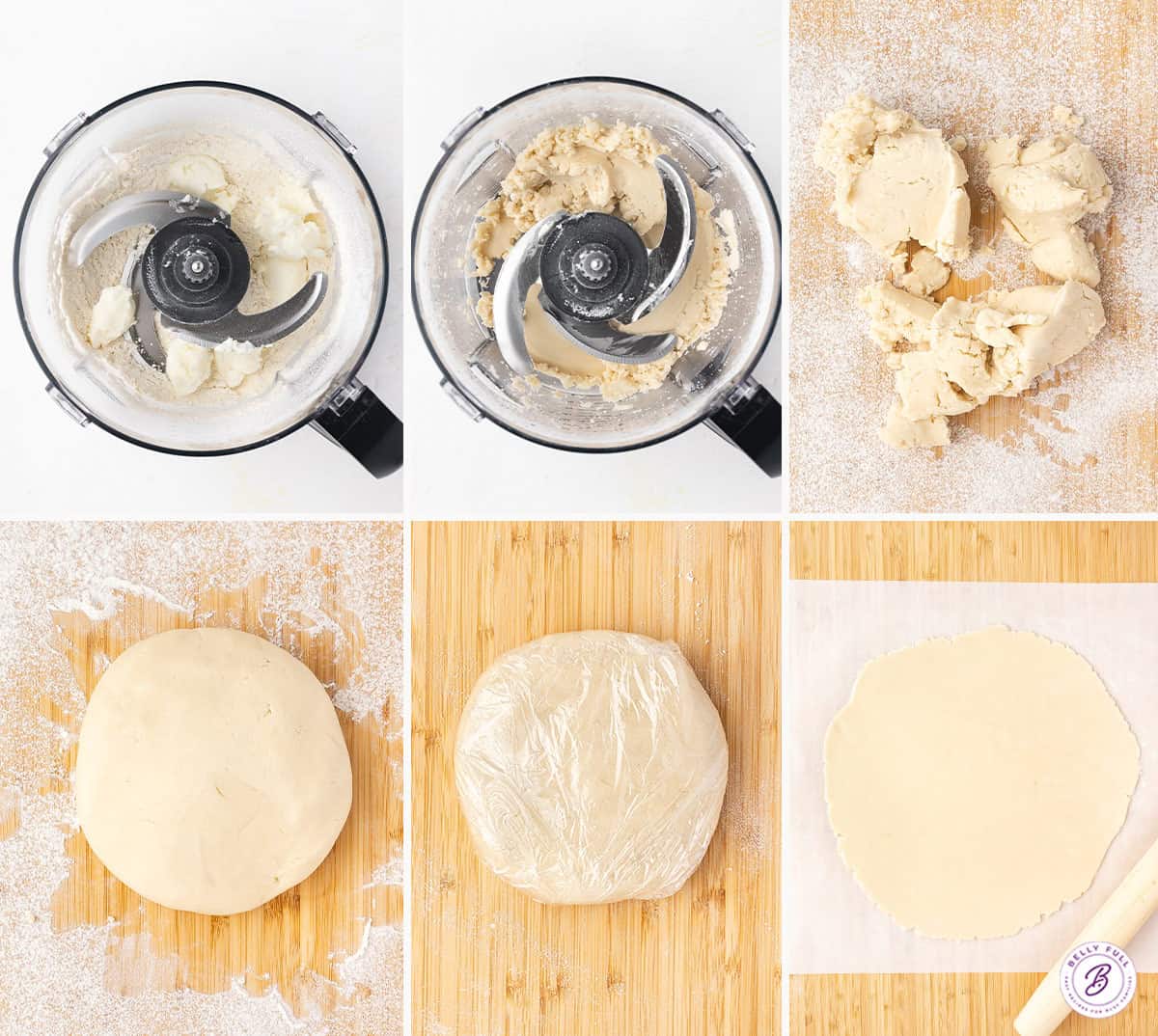
How To Make Pie Crust
Making pie crust might take a bit of practice, but the end result is 100% worth it! You can find the complete detailed instructions in the recipe card below.
- Mix together the flour and salt – put the flour and salt into the bowl of a food processor and pulse a few times to combine.
- Add in the shortening – cut the shortening into cubes and sprinkle it on top of the flour in different places. Pulse several times (about 15) until the mixture resembles large pea-sized crumbs and changes to a darker color. Take a little bit of the mixture and pinch it together with your fingers; if it holds together, your dough is ready for the water.
- Slowly add in the water – remove the food processor lid cap and slowly drizzle in the ice cold water while pulsing, until the mixture just starts to form a ball. Don’t over-process.
- Test the texture of the dough – take some of the mixture and pinch it together with your fingers; if it holds together, your dough is good to go. If it’s still crumbly, add a little more water (but no more than a tablespoon at a time. Too much water will require more flour, which will make the crust tough.)
- Form the dough into a disc – transfer the dough mixture onto a clean, dry, flat surface that’s been lightly dusted with flour. Gather into a mound, then fold the dough into itself until the flour is fully incorporated. (The dough should come together easily and should not feel sticky. Don’t over-knead. You should just knead enough so that the dough holds together without cracks.) Then flatten the mound into a 1-inch thick disc, making sure there aren’t any open edges or cracks.
- Wrap and chill – wrap the dough tightly in plastic wrap and refrigerate for 30-60 minutes.
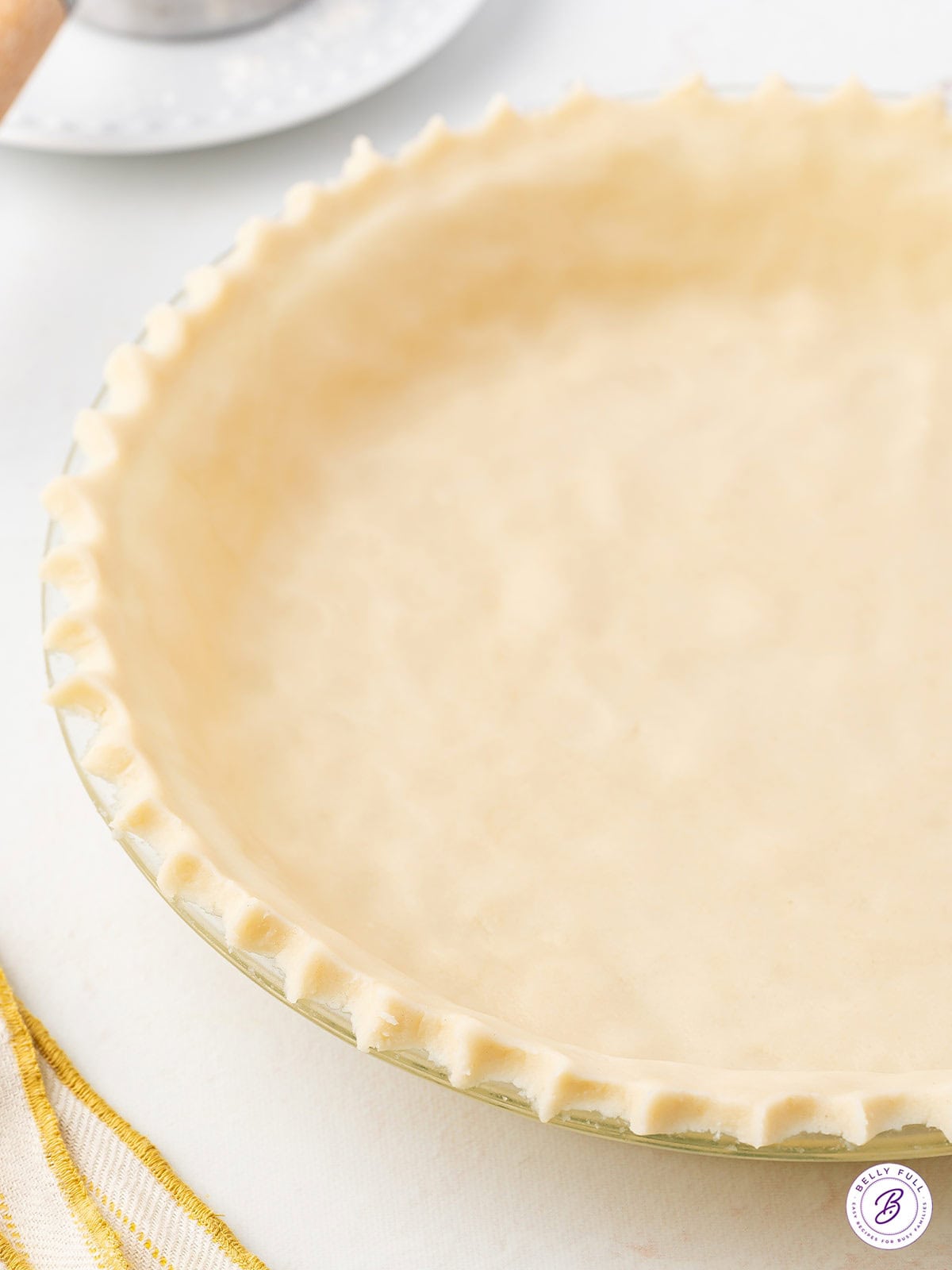
How to Roll Out Pie Crust
- Let the chilled dough warm up a bit. After the dough has chilled, remove it from the refrigerator and let it sit for just a few minutes while you prep your work surface to roll it out.
- Cut parchment and wax paper. Cut a large piece of parchment paper; lay it on a clean, dry, flat surface and sprinkle with a little flour. Cut a similar sized piece of wax paper. Place your dough disc on top of the parchment paper and sprinkle with a little flour, then place the wax paper on top of the dough.
- Start to roll out the dough using a rolling pin. You want to roll with purpose, but gently. Start rolling from the center to the outer edge, in single strokes, making sure to move in all directions, turning as you go, so that your crust stays in a general circular shape. Roll, turn, roll, turn, etc. If the dough is sticking to the wax paper as you roll, add a few sprinkles of flour on top of the dough, and continue rolling.
- Roll the dough into a 12-inch circle, about 1/8 inch thick. I then transfer the dough into a 9-inch pie plate, which allows me to trim and crimp the edges. My mom always uses a 10-inch pie plate, so there isn’t any excess and that’s ok, too!
How To Transfer the Crust to a Pie Plate
There are 3 different ways (that I know of!) to do this. After you make a ton of pie crust (and you’re going to, right?), you’ll try all three and pick your preferred method.
- Use the rolling pin. You roll the flattened pie dough onto the rolling pin, transfer to the pie plate and unroll.
- Use a dough blade. Take a lightly floured dough blade and carefully work it gently under the pie dough edges. Then, using the blade to help you as needed, gently fold the dough in half, then into quarters. Place the quartered dough into your pie plate and unfold it.
- Use a cutting board. Slide the parchment paper (with the rolled out dough) onto a large cutting board, then flip your pie plate upside down on top of the dough and invert.
Once you’ve transferred the dough, you’ll gently press down so that it lines the bottom and sides of the pie plate. Use a pair of kitchen scissors or sharp pairing knife to trim the dough to within 1/2 inch of the edge of the pie dish. But, wait! You’ve got some tears and there’s much sadness. DON’T FRET! Just simply use your fingertips and gently press together any tears or cracks.
Tips For A Perfect Crust
- Use ice cold water to bind the dough. Make sure you use ice cold water, but without the ice.
- If possible, use a food processor. You absolutely can use a dough blender to combine your ingredients, but I prefer a food processor because it does a better job of thoroughly distributing the shortening.
- Glass pie plates are ideal to make pie. Glass transmits heat evenly, which ensures the bottom of the crust will cook through. Plus, you can see when the bottom and sides have browned.
- Use a pie crust shield to prevent the crust from over-browning. I like to use an adjustable silicone pie crust shield that you can fit to the size of your crust. You can also go old school and use a piece of aluminum foil gently wrapped just around the crust rim.
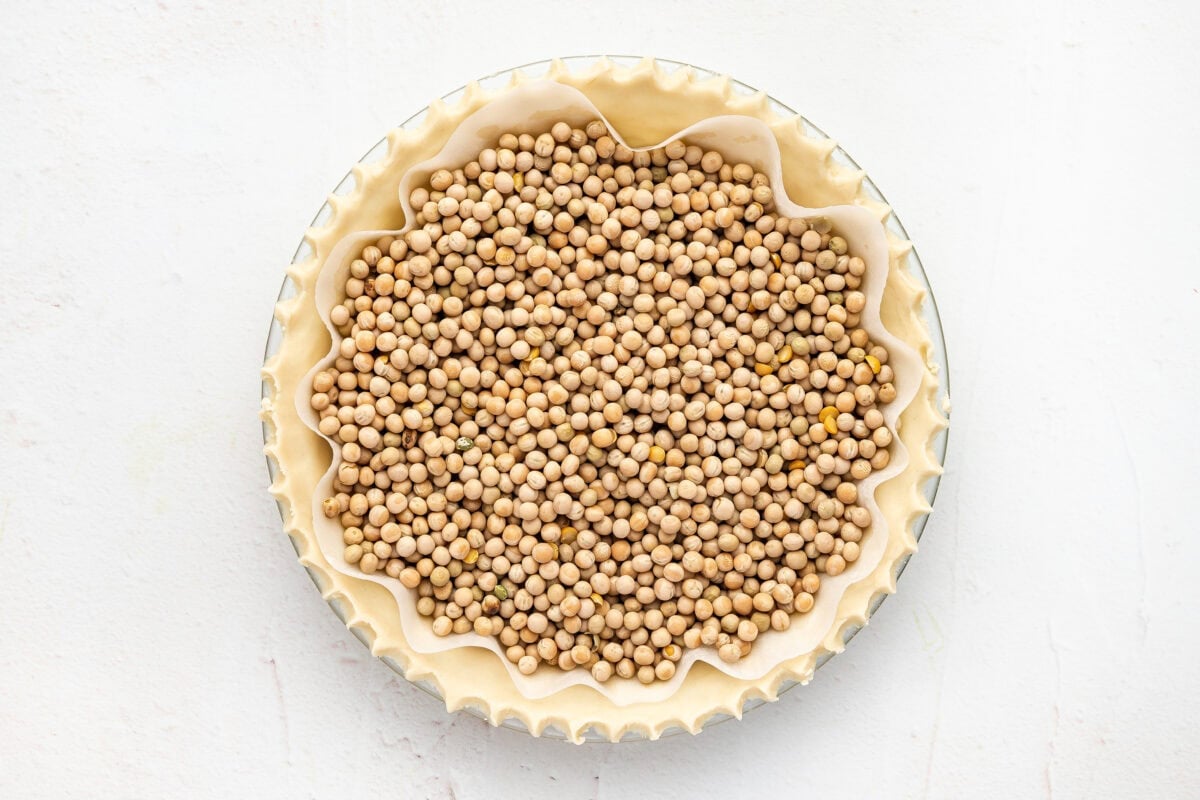
When To Blind Bake Pie Crust?
Blind baking, Pre-baking, and Par-Baking (which stands for Partial Baking) refers to baking pie crust without a filling. Why would I bake pie crust without a filling, you ask? There are a few instances – when you’re making quiche, custard pies, pudding pies, anytime your filling doesn’t need to be cooked (as in no-bake pies), or if the filling cooks faster than the crust. This article on how to par-bake pie crust has more details.
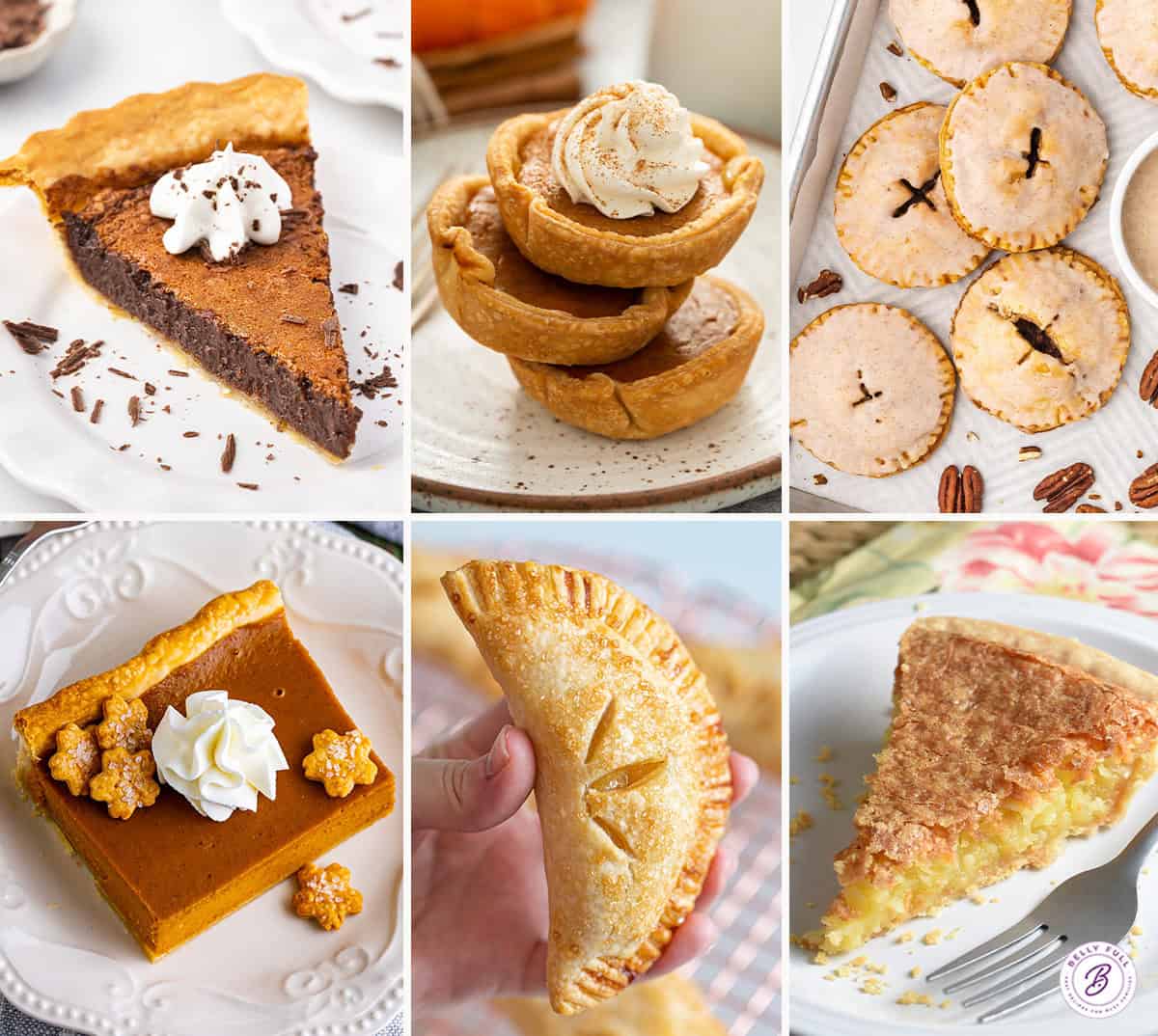
Ways to Use a Pie Crust
The beauty of making pie crust is you can use it for all the different pie recipes, whether they’re for fruit pies or cream pies, a slab pie, or cut circles out for mini pecan pies and air fryer apple hand pies! Try this pie crust recipe on some of my favorites pie recipes, such as chocolate pie, coconut pie, and peach pie!
Can I make Pie Dough Ahead and Freeze?
So you’ve made this pie crust recipe, but you don’t need it immediately. You can prepare the pie dough, wrap it up as instructed and place the disc in the refrigerator for up to 2 days or freeze in a freezer-safe plastic bag for up to 3 months. Thaw overnight in the refrigerator before rolling it out.
I hope you love this easy delicious recipe – be sure to give it a review below! Also don’t forget to follow Belly Full on TikTok, Instagram, Facebook, Pinterest, and YouTube!
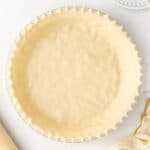
Homemade Pie Crust
Ingredients
- 1 & 1/2 cups all-purpose flour , spooned and leveled
- 1/2 teaspoon salt
- 1/2 cup shortening (see note below)
- 3 tablespoons ice cold water
Instructions
Process the Dough Ingredients
- Put 1 & 1/2 cups all-purpose flour and 1/2 teaspoon salt into the bowl of a food processor and pulse a few times to combine.

- Cut 1/2 cup shortening into cubes and sprinkle it on top of the flour in different places.
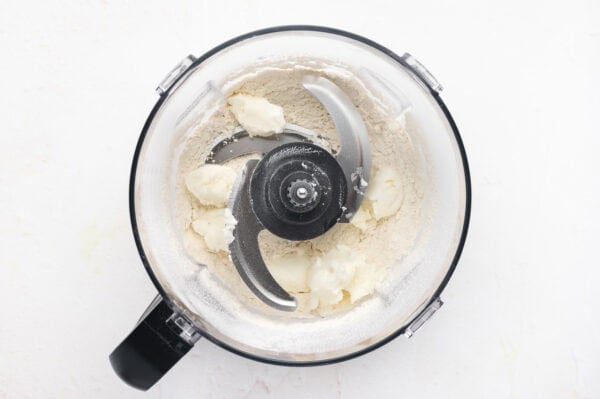
- Pulse several times (about 15) until the mixture resembles large pea-sized crumbs and changes to a darker color. Take a little bit of the mixture and pinch it together with your fingers; if it holds together, your dough is ready for the water.
- Remove the food processor lid cap and slowly drizzle in 3 tablespoons ice cold water while pulsing, until the mixture just starts to form a ball. Don't over-process.
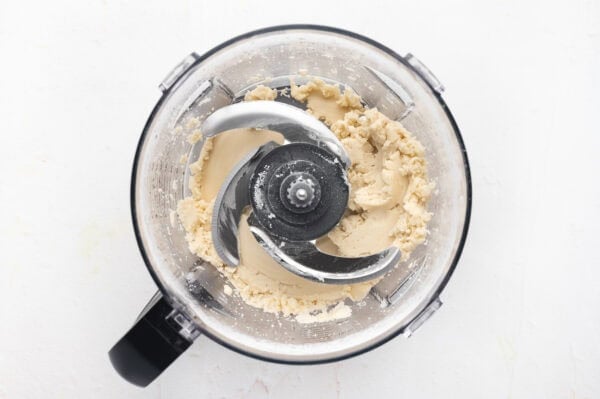
- Take some of the mixture and pinch it together with your fingers; if it holds together, your dough is good to go. If it’s still crumbly, add a little more water (but no more than a tablespoon at a time. Too much water will require more flour, which will make the crust tough.)
Form the Dough & Chill
- Transfer the dough mixture onto a clean, dry, flat surface that’s been lightly dusted with flour.
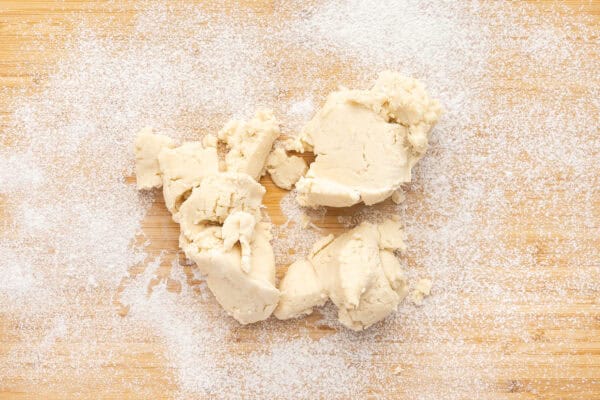
- Gather into a mound, then fold the dough into itself until the flour is fully incorporated. (The dough should come together easily and should not feel sticky. Don’t over-knead. You should just knead enough so that the dough holds together without cracks.) Then flatten the mound into a 1-inch thick disk, making sure there aren’t any open edges or cracks.
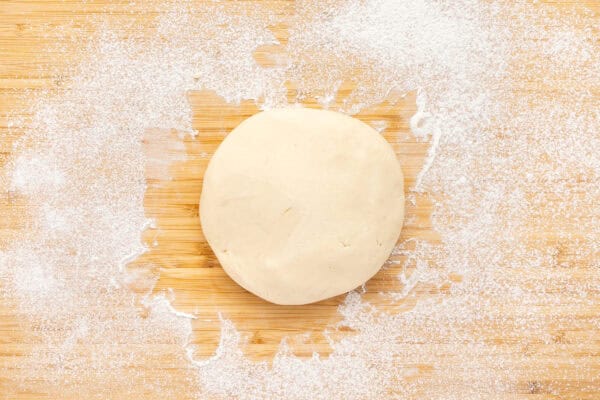
- Wrap the dough tightly in plastic wrap and refrigerate for 30-60 minutes.
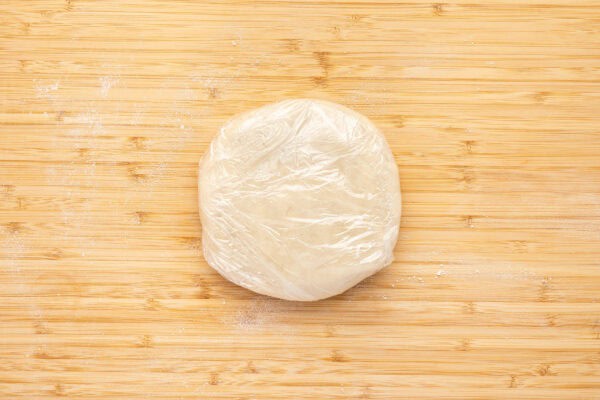
Roll out the Dough
- After the dough has chilled, remove it from the refrigerator and let it sit for a few minutes while you prep your work surface to roll it out.
- Cut a large piece of parchment paper; lay it on a clean, dry, flat surface and sprinkle with a little flour. Cut a similar sized piece of wax paper.
- Place your dough disk on top of the parchment paper and sprinkle with a little flour, then place the wax paper on top of the dough.
- Using a rolling pin, start to roll out the dough. You want to roll with purpose, but gently. Start rolling from the center to the outer edge, in single strokes, making sure to move in all directions, turning as you go, so that your crust stays in a general circular shape. Roll, turn, roll, turn, etc. If the dough is sticking to the wax paper as you roll, add a few sprinkles of flour on top of the dough, and continue rolling.
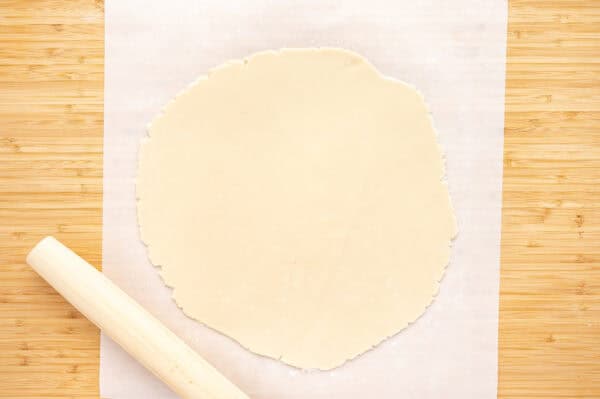
- Roll the dough into a 12-inch circle, about 1/8 inch thick. (I then transfer the dough into a 9-inch pie plate, which allows me to trim and crimp the edges. My mom always uses a 10-inch pie plate, so there isn’t any excess and that’s ok, too!)
Transfer the Dough to Pie Plate
- Transfer the dough to your pie plate with a rolling pin, dough blade, or cutting board. Gently press down so that it lines the bottom and sides of the pie plate.
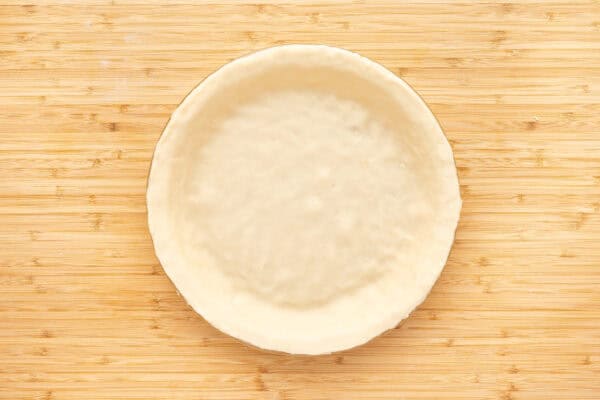
- Use a pair of kitchen scissors or sharp pairing knife to trim the dough to within 1/2 inch of the edge of the pie dish. (If you've got some tears DON’T FRET! Just simply use your fingertips and gently press together any tears or cracks.) Crimp the edges.
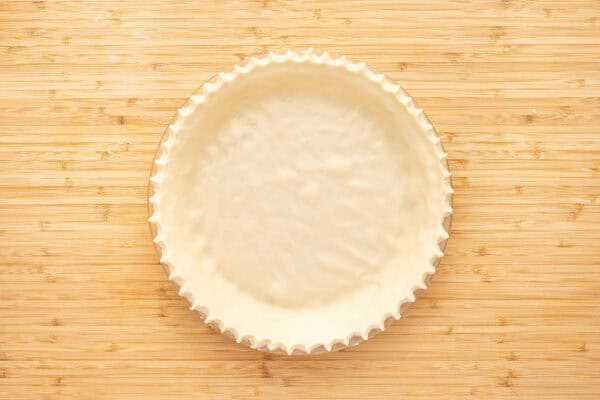
Make all the pies!
- Proceed with whatever pie recipe you’re making! (Some recipes do call for a fully baked pie crust or a partially baked crust, so pay attention to that.) Don't miss all the helpful tips about forming and rolling the pie crust, and blind baking in the article.

You are the best easy and simple thank you so much for sharing your passion with us.
The directions on this was so much easier to follow than one that I had tried before(by time it was rolled out to fit as a pie it was paper thin). I will definitely hold on to this pie crust recipe…..Thank You.
When using lard (instead of shortening), would I just follow the recipe measurements the same as in this recipe?
Yep!
I finally made a good pie crust! I’ve tried quite a few – this one was easy. Thank you Amy to you and your Mom for the excellent how-to video – it really helped. And the link to the crimping video was great too.
I would love to try this recipe but don’t have a food processor. Is there an alternative hand way to make this? I do have a blender, an electric hand mixer, strong arms and lots of patience. Just getting started cooking different desserts at home but don’t have a budget for new kitchen gadgets. ?(Darn inflation!)
Hi Ashley! As mentioned in the article, you can use a dough blender (https://amzn.to/3ZdZXCN) – you’ll have to put some muscle into it and be thorough, but it’ll work.
I don’t have a food processor what else can I use
Hi Marcy! As mentioned in the article, I prefer a food processor because it does a better job of thoroughly distributing the shortening. But you can use a dough blender/pastry cutter.
Perfect pie crust, thank you!
I did half butter and half shortening, came out GREAT!
I’ve been so scared to make a pie crust, but your instructions were awesome. Thank you for this!
I agree shortening is the way to go for pie crust!
You nailed it! I’ve made it this way for years (married 67 yrs) and have yet to have a failure. I also agree shortening is by far the best, as much as I love butter, not in the recipe.
I’ve been making this crust for years, it’s the best. When I make it I make a few batches and freeze it.It freezes well
I made it and it was so delicious. Thanks for sharing recipe
Absolute pie crust perfection!
I don’t have a food processor. Can I just use a fork to keep blending?
Hi Lenora – I prefer a food processor since it tends to blend all the ingredients so thoroughly, but if you have pastry/dough dough blender, that will work fine.
Seriously helpful tutorial, Amy! I am SO unbelievably lazy and almost ALWAYS use store-bought crust. But homemade is leaps and bounds better. I need to “retire” and take up a new life as a baker or something.
Oh goodness, I need your help Amy… The last pie I tried to bake was a soggy disaster! I hadn’t baked a pie in 2 years, and I’d never thought to parbake the crust… That probably would’ve helped a bit. As would your awesome recipe!
I’m an all butter food processor girl myself, but I really should give this method a try!! An excuse to make pie? You know I’m in.
To me it’s not the perfect recipe, but the perfect ‘touch’. I can’t say anything more definite than that. Twice in my life I made a lot of pies and my crust was flakey heaven. It’s been a while since I have been in that pie crust zen mode. It’s a space I am yearning to be again.
Love me a good pie crust!
I love your disclaimer in the beginning. So true that everyone does something so simple a little differently. Thanks for sharing your version!
Haven’t tried recipe yet, but I intend too. Can remember my Grandmother picking up crust in her hands and transferring it to pie plate. She used her fingers to break up shortening. She would have liked this way!! ?
I love your disclaimer at the top of this post. It makes me think pie crusts are like writing – there’s so many ways to say something…just like there’s so many ways to make a pie crust. Love it!
It’s true-so many recipes and options to make simple pie crust. I finally found my go-to recipe about 5 years ago. Does anyone else use the sometimes called “heart healthy” recipe? It’s made with flour, oil and low-fat cold milk. I use it because it comes together so quickly-rolls out beautifully-is easily repaired or patched, and can easily be sweetened or made savory with cheese added. It is also the only crust I have ever made that bakes beautifully without being filled. It never slides down. Four ingredients stirred with a fork, rolled on wax paper. That’s for me!
Pie crust is like bread – you’ve got to let go and learn to love it. Then it will all work out!
I love making my own crust. I personally do a mixture of butter and lard (it’s not gross I swear!) but I have made it with shortening before and liked the results. In my opinion any homemade pie crust is awesome :)
I have used butter flavored Crisco and like it.
Loved the disclaimer, and loved the indecision re busy & lazy!
There are certain things I just know I’m not set out to do. Pie crust is one of them.
That indecision actually went on a few more times. It’s both, really!
Hahah. I love the disclaimer at the beginning of this post. It’s SO true. People have a lot of opinions about their pie crust! I actually tested out a couple of different recipes earlier for the blog, and honestly they were all good, just different. Depends on what you like. And I think like you said, a lot of it has to do with what you grew up with. This crust looks perfectly flaky and delicious!
Isn’t it funny how pie crusts can be personal – I cracked up at your disclosure. Yours looks perfect!
I make my pie crusts with all shortening, just like you, unless it’s for a savory dish, in which I sometimes include butter. I do just fold mine in half though. :)
I come from a pie family–apples from the orchard, rhubarb in the spring. We always use the old Betty Crocker recipe (from the 1950s cookbo0k). It is almost exactly like yours, except half the shortening is cut into the flour and then the other half. It usually rolls like a dream! ICE cold water is key.
Looks like you had success with combining, rolling and placing in pie plate. Now how did it bake?
Or did you freeze for later use?
I froze it first, then made a Strawberry pie which you’ll see next week. It came out beautifully!
This does look the perfect pie crust, cant wait to try it.
yep, looks pretty perfect to me!
I’m so excited to try this with my girls. I’ve never tried to make one – yikes! It’s on my summer bucket list!
I agree with you on learning about pie crust through alot of practice. All these little tricks like egg, vodka or vinegar don’t really help as much as a perfectly executed basic crust made with shortening, flour and water.
May I just say, it’s about time that we learn your pie crust recipe and techniques since you ARE the Queen of Pie!
“Buttery” crust sounds good, but my mother ALWAYS used Crisco shortening and it makes THE MOST flaky crust ever! Don’t you find it amazing that three basic ingredients plus water can make something so wonderful? (I like Pillsbury’s crust, too, but there are times we need pie NOW and homemade crust is our only option.)
?
Dani, I was JUST saying that to someone the other day – about three basic ingredients making magic. I swear, I could forego the filling and just eat the crust!
You can never have too many pie crust recipes. :) They all work so differently and I’m excited to try yours!
I too am guilty of the refrigerated pie crust. The ONLY time I make homemade is usually in the fall after we go apple picking. I’ll have to give your recipe a shot in the fall.
My cousin and I were recently talking about this. We come from a long line of bakers — but I’ve never made pie crust and she chooses not to (although she knows how). We both opt for Pillsbury. Still, it’s on my bucket list to try making my own, and this is so helpful. Thanks!
Well NOW I want a homemade pie. My rolling pin has been sadly neglected for a while ; ) Time to get rolling.
You use the same recipe that I use 99% of the time. I’ve been making pie crusts since I was a freshman in high school (well, consistently) which was a long. time. ago. And, it was all shortening. Fast forward 12 years to when I got married, and being a (stupid) newly wed, with no job and time on her hands, I made a pie for us with a homemade crust. That was it. No backing out. So, I’ve made homemade crusts ever since then. Stephie has seen me make so many pie crusts–dare I say 100s of them? Anyway, I was impressed by her tutorial. I guess she did learn a few things from me over the years. Thanks for the shout-out for her. Let’s eat pie together sometime, ok? <3
Us pie gals have to stick together. Who are all these crazy people who prefer cake? Pffft. Lol.